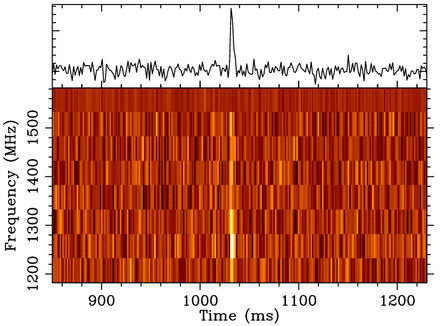This article is more than 1 year old
MYSTERY RADIO SIGNAL picked up from BEYOND our GALAXY
'Fast burst' from the past blasts past
The Australian Parkes radiotelescope – even though under threat from budget cuts – has produced its first chunk of science for 2015, and it's a substantial one indeed. The mighty Antipodean instrument has given astronomers their only real-time view so far of the unexplained phenomenon known as the Fast Radio Burst (FRB).
FRBs were first observed by astronomers looking through archival data from “The Dish”, and received the first independent confirmation of their existence in 2013.
Now, astro-boffins have had a hot bet pay off: a team of astronomers from Swinburne University led by PhD student Emily Petroff developed a technique to look for FRBs in real time and used the 64-metre radio-telescope to see if it would work.
The event was caught by Parkes' real-time transient pipeline: “We record 8-bit full-polarization data from two orthogonal linear feeds per beam, with 1024 frequency channels over 400 MHz of bandwidth, from 1182 to 1582 MHz, and 64-μs time resolution”, the researchers' paper states.

A millisecond sun: the plot of the FRB
Image: Petroff et al
So that their work wouldn't be dismissed as a measurement artefact, Swinburne explains in its release, an international team was lined up to make follow-up observations in wavelengths all the way up to X-ray.
The FRB is well outside the Milky Way, at 5.5 billion light-years' distance.
The University of Copenhagen Niels Bohr Institute's Daniele Malesani told Astronomy Now the Swift space telescope observed two X-Ray sources at the same position as the FRB, but these were ruled out by the Nordic Optical Telescope at La Palma.
“We observed in visible light and we could see that there were two quasars, that is to say, active black holes. They had nothing to do with the radio wave bursts, but just happen to be located in the same direction,” explained Giorgos Leloudas, also of the Niels Bohr Institute and Israel's Weizmann Institute.
It turned out that the FRB didn't show up in the infrared or UV spectra either, so while it put out energy equivalent to the Sun's daily output in a few milliseconds, what causes FRBs is so far still a mystery.
There is, however, another hint that the Parkes group was able to capture. The signal shows more than 20 per cent circular polarisation, suggesting that the source of the FRB was close to a strong magnetic field.
The paper is available in full from Monthly Notices of the Royal Astronomical Society, here. ®
